
Typography plays a crucial role in long-form content, whether you’re crafting a blog post, article, or research paper. Choosing readable fonts ensures that readers can comfortably engage with the content without eye strain or distraction. In this article, we will explore the characteristics of readable fonts, the best practices for selecting them, and specific examples of fonts that work well for long-form content. Understanding how to balance readability with design can make your content more inviting and accessible to a broader audience.

Readability is critical in long-form content because it affects how well readers can absorb and comprehend the material. Long articles, research papers, or in-depth guides can quickly become tiring if the typography is not designed for easy reading. Fonts that are too small, too dense, or overly decorative may reduce comprehension and cause readers to abandon the content prematurely. A readable font ensures that readers stay engaged from beginning to end.
Typography contributes significantly to the user experience by guiding readers through the content smoothly. Fonts can create a pleasant reading flow or disrupt it, depending on their clarity and spacing. In long-form content, where readers spend more time immersed in text, the choice of font influences how easily they can navigate the content and how enjoyable their reading experience will be.
Not all fonts are suitable for long-form reading. Readable fonts tend to share common characteristics that make them easier on the eyes. Here are a few essential qualities of fonts designed for readability.
Choosing a readable font involves more than just selecting a typeface that looks good. The context of the content, the platform on which it will be consumed, and the intended audience all play a role in determining the best font. Here are some best practices to keep in mind when selecting fonts for long-form content.
The medium in which your content will be published—whether it’s print, web, or mobile—should influence your font choice. Print materials generally benefit from serif fonts like Times New Roman or Garamond, while digital content is often better suited to sans-serif fonts like Arial or Helvetica for improved screen legibility.
Font size plays a significant role in readability. Too small, and the reader struggles to see the text; too large, and it can feel cumbersome to read. The standard size for body text in long-form content is typically between 16px and 18px for digital formats, but this can vary depending on the audience and platform.
Fonts with well-proportioned letter spacing and kerning are easier to read, especially in long-form content. Proper spacing helps prevent letters and words from blending together, which can cause fatigue for the reader. Ensuring that the font has adequate line height and word spacing will also improve readability.

Now, let’s look at some of the top fonts that have been proven to work well for long-form reading. These fonts are highly readable and widely used for both print and digital content.
Georgia is a popular serif font known for its excellent readability on both screens and printed materials. It has wide, clear letterforms and generous spacing, making it ideal for long-form content. Georgia was designed specifically for readability on screens, which makes it a great choice for web articles and ebooks.
Times New Roman is a classic serif font that has been used for decades in newspapers, books, and academic papers. Its timeless appeal and strong legibility make it a reliable option for any type of long-form content. While it may feel a bit formal for casual digital formats, it excels in more traditional and formal contexts.
Arial is one of the most widely used sans-serif fonts, known for its simplicity and clarity. Its clean lines and balanced spacing make it easy to read in large blocks of text, which is why it is often used for long-form digital content like reports and articles. It is also commonly used in business documents and presentations.
Merriweather is a serif font designed specifically for readability on screens. Its slightly condensed letterforms and high x-height make it an excellent choice for digital long-form content. Merriweather is also versatile and pairs well with sans-serif fonts like Open Sans for a balanced, readable design.
Verdana is a highly readable sans-serif font, designed for use on low-resolution screens. Its wide letterforms and generous spacing make it easy to read even on smaller devices. Verdana works well for both web and mobile long-form content, and its readability remains consistent at various text sizes.

Font pairing involves combining two or more fonts that complement each other in a single piece of content. In long-form writing, font pairing can create contrast, emphasize important points, and guide the reader through different sections of the text. Here are a few tips for pairing fonts effectively in long-form content.
Readable fonts play an essential role in ensuring that long-form content is accessible, engaging, and easy to consume. By choosing fonts that prioritize clarity, appropriate spacing, and proper sizing, content creators can enhance the user experience and keep readers focused on the material. Whether in print or digital, selecting the right fonts for long-form content helps reduce eye strain, improve comprehension, and create a pleasant reading journey.
When it comes to long-form content, the balance between aesthetics and functionality is key. Readable fonts like Georgia, Arial, and Merriweather prove that typography choices can significantly impact the overall success of written work. Whether you’re creating an academic paper, a blog post, or an ebook, understanding how to choose and pair fonts for readability will help you deliver content that resonates with your audience.